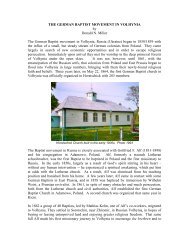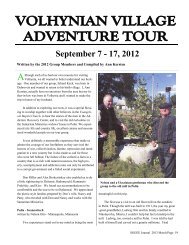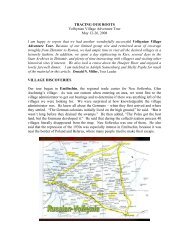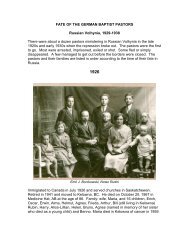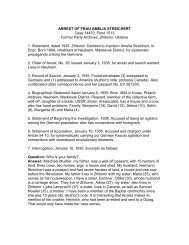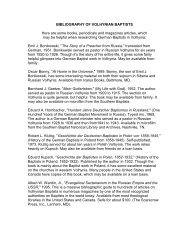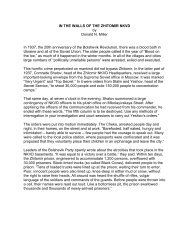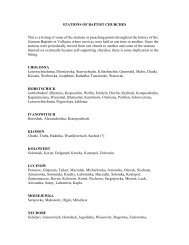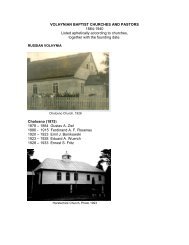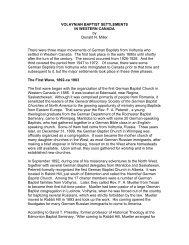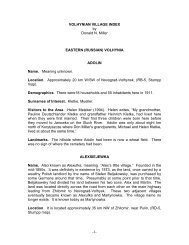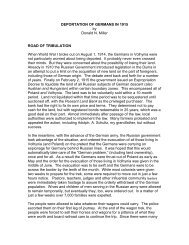here - Volhynia
here - Volhynia
here - Volhynia
You also want an ePaper? Increase the reach of your titles
YUMPU automatically turns print PDFs into web optimized ePapers that Google loves.
Views of Field and Forest<br />
A Report on the 2011 <strong>Volhynia</strong>n Adventure Tour<br />
Dan Friedenberg and Karen Helm<br />
On September 3, 2011 sixteen North Americans, comprised of fourteen members and friends of one<br />
Canadian family, and two sisters from the United States, arrived in Kiev to join Don Miller on his annual<br />
<strong>Volhynia</strong>n Adventure Tour. Our reasons for traveling to Ukraine shared a common theme- to find the<br />
villages that were the birthplaces of our parents or grandparents, to walk on the soil of their homeland,<br />
to gaze upon the fields and forests that they spoke of, to see if anything remained of their presence in<br />
that place.<br />
Don Miller directs the group as his<br />
wife Nancy leads the way at the Kiev<br />
airport.<br />
Ron Schlender persuaded many of his family members to<br />
travel with him on his fourth visit to Ukraine. Joining Ron<br />
were his wife Joanne, son Curtis, daughter Andrea and sonin-law<br />
Kim Zazula. Ron’s sister Lil, her husband Earl<br />
Jesperson , and their daughter Colleen Barbe also traveled to<br />
see the birthplaces of Ron and Lil’s parents. Nieces Sandy<br />
Haverland and Doreen Acorn joined in the family tour,<br />
because as Doreen related, “I thought it would be a hoot to<br />
join the bunch, and it was.”<br />
Dan and Kathy Friedenberg decided to join this tour after<br />
some encouragement from Ron and Joanne Schlender. Ron<br />
had been in Ukraine three times before and indicated that this tour was a chance in a lifetime to see the<br />
rural areas of the Ukraine. Dan’s grandparents Emanuel and Otillie Friedenberg immigrated from<br />
Matschulek, <strong>Volhynia</strong> in 1904. Emanuel was nineteen and Otillie was sixteen years old. As the story<br />
goes, Emanuel was drafted into the Russian Army so he decided to leave for Canada. His girlfriend,<br />
Ottilie Krause, was not allowed to leave unless they were married, so they were married and headed off<br />
on a new adventure.<br />
Milt Breitkreuz and his wife, Wendy, were also invited by Ron to join the group. Milt’s parents, Ewald<br />
Michael Breitkreuz and Adeline Froehlich, were born near Kolowert and immigrated to Canada as young<br />
people in 1927 and 1929. Having dated in Kolowert, they married in Canada. Like several other members<br />
of the group, Milt remembers that his parents referred to their homeland in a negative context due to<br />
the experiences of war, revolution, and poverty that they experienced in their homeland.<br />
The U.S. sisters, Linda Boman and Karen Helm, joined the tour to visit the homeland of their paternal<br />
grandparents, Albert Datte and Theophilene Noerenberg, who immigrated with their families when they<br />
were children. Theophilene’s brother, Gustav, was drafted into the Czar’s army in 1913. Their father,<br />
Martin, had been in the Russian army cavalry for thirteen years, almost losing his arm to a saber in the<br />
Russo-Japanese war. Martin did not want his oldest son in the Army, so Gustav went underground to<br />
escape the draft. The rest of the family followed, meeting in Bremerhaven to journey to Bay County,
Michigan. Albert’s father, August Hippolit Datte, brought his family of eleven children from Pokaschew,<br />
<strong>Volhynia</strong> to Bay County, Michigan in 1902.<br />
After our arrival at the Kiev airport, we travelled in a small bus to our hotel in Sadki. The<br />
accommodations were new, clean, and comfortable and, according to Don Miller, quite a change from<br />
the conditions on the early tours he conducted. The next morning we attended church services at the<br />
Baptist church in Neudorf. The small congregation welcomed us graciously and we enjoyed their<br />
beautiful and enthusiastic singing. We even recognized the melodies of several of our favorite hymns. Lil<br />
Jesperson recounts, “Attending the church service was a highlight of the trip and standing with my<br />
brother Ron at the site of the pool w<strong>here</strong> our mother was baptized was a very special moment.”<br />
Lil Jesperson and Ron Schlender at<br />
the baptismal pool site near the<br />
Neudorf Baptist Church<br />
Exterior of the Neudorf Baptist Church<br />
Chapel w<strong>here</strong> we attended services at the Neudorf Baptist Church
Our busy first day also included touring a modern farm, a visit to the ruins of the Lutheran Teachers<br />
Seminary in Heimtal, and a delicious home-cooked feast at<br />
the home of Maria and Victor Polishuk, pastor of the local<br />
Baptist church. At the former site of the Lutheran church<br />
in Heimtal, we chanced upon a small Catholic congregation<br />
as they were leaving their Sunday afternoon services. The<br />
parishioners were friendly and happy to see us,<br />
foreshadowing more friendly encounters with villagers,<br />
food vendors, and flower ladies in the coming days of our<br />
Well-fed and happy tour members at<br />
the home of gracious hosts, Victor<br />
and Maria Polishuk<br />
tour.<br />
Catholic parishoners visiting with tour<br />
members.<br />
Earl Jesperson (right) takes a ride in the horsedrawn<br />
cart that brought this couple to the<br />
Catholic services.<br />
The following days included trips to our family villages and other historical sites of the area. Dan<br />
Friedenberg describes his visit to his family village, Matschulek, as follows: “I was excited on the<br />
morning that we were to travel to Matschulek. The weather was a little overcast and we encountered<br />
rain as we travelled from Zhitomyr to Matschulek. We had to stop a couple of times to seek directions<br />
from the local people and they were only too happy to oblige us. As we neared Matschulek, the road<br />
became very narrow and was skirted by tall, mostly evergreen, trees. We entered the village of<br />
Matschulek on a cobble stone street and stopped at the first house to seek more directions to the<br />
Baptist Cemetery and to see if they knew the family name, Friedenberg. They directed us to the<br />
neighbors who were elderly and might know more information. The neighbors did not know of the<br />
family name, but indicated that a bus load of German people had been at the cemetery six or so weeks
ack. At this point, I thought that we would not find much except maybe an overgrown cemetery. We<br />
arrived at the cemetery and as we walked past some of the more modern Ukranian grave markers, we<br />
saw a larger monument that looked as if it was recently erected. Eureka!!! We hit pay dirt. The<br />
monument didn't only have my family name, Friedenberg, engraved on it but also Milton Breitkreuz's<br />
family name and not to be out done, Ron and Lillie Schlender's mother's maiden name Guse. The<br />
monument was erected to signify the good relationship that was enjoyed between the German and<br />
Ukranian people in the years 1860 to 1940. The monument has 117 German family names inscribed on<br />
it. When we returned home Kathy found a <strong>Volhynia</strong>n information-sharing website and t<strong>here</strong> was an<br />
entry by Erhard Betker some years earlier. I decided to email Erhard and did not expect an answer. Well,<br />
several days later Erhard answered and attached an article on the dedication ceremonies of the<br />
monument at Matschulek on June 17, 2011. Life in Matschulek at the present time is very modest and<br />
people live a very simple life without all of the frills that we enjoy.”<br />
The monument in Matschulek
Karen Helm and Linda Boman travelled separately with their<br />
guide, Paul, to Negrebowka w<strong>here</strong> their grandmother was born.<br />
Negrebowka is located in the far eastern portion of what was<br />
Russian <strong>Volhynia</strong> and is far from any major road. Karen<br />
describes the village tours. “Paul was concerned that we might<br />
not find it, but with the help of several locals and Paul’s antique<br />
GPS (a paper map) we found the small village which now<br />
consists of only four houses. We stopped at the first house and<br />
asked a friendly Babushka (grandmother) if she knew anything<br />
about Germans who had lived t<strong>here</strong> in the past. She directed us<br />
to the home of Vasily Nickolaiovich, the oldest resident of<br />
village, and also pointed out the area which was known as the<br />
“German Cemetery”. After a short trip down a rutted dirt road<br />
we found the rustic home of Vasily, a delightful, friendly<br />
Do these Birch trees mark the old<br />
cemetery road?<br />
gentleman. Did he remember anyone named Noerenberg? Yes, he replied he had gone to school with<br />
some Noerenbergs, but they lived in Rakowitsch, a village about three kilometers away.<br />
Vasily Nickolaiovich and his colorful<br />
home in Negrebowka<br />
Former Postmistress of Rakowitsch<br />
and Karen Helm<br />
We searched the woods for evidence of cemetery plants like lilac bushes or hens-and-chicks,and holes<br />
that would give evidence of grave-robbing in times of war and famine. We found nothing like that, but<br />
suddenly Paul pointed out two straight lines of old birch trees through the forest. Did they mark the old<br />
line of the road to the cemetery?<br />
We traveled on to Rakowitsch and happened upon the former postmistress who was waiting at her gate<br />
for her cows to be brought home for the afternoon milking. Yes, she remembered that Rudolf<br />
Noerenberg had lived across the road. Other Germans lived down the road, w<strong>here</strong> their yellow flowers<br />
still grow. She related that the Germans had been very good farmers and grew wonderful strawberries<br />
and watermelons in the sandy soil. These stories ring true. Our family left this area in 1913, but I know
that one brother, Adolf Noerenberg, remained with his family and EWZ records list Noerenbergs that<br />
lived in Rakowitsch. It was a joy to find that people remembered the name even though my family left<br />
this area 98 years ago.<br />
Pokaschew is a village of about a dozen houses with most of them having German-style construction.<br />
German-style houses use a dovetail corner construction rather than the straight vertical corner post that<br />
is typical of Ukrainian houses. The first house we stopped at was abandoned, but the large old apple<br />
trees were still bearing delicious fruit. We had a snack of fresh apples and then stepped across the street<br />
to another house. It was also abandoned and it was open! We explored the interior of the house,<br />
speculating that it very well might have been Grandpa’s house. Also a German-style house, it was<br />
remarkably solid. Paul even hoisted himself into the attic. The antique door hinges and ceramic stove<br />
truly took us back to the times of our ancestors.”<br />
German-style house in Pokaschew<br />
Ceramic stove in the abandoned<br />
house in Pockaschew<br />
Paul samples the apples in Pokaschew
This tour was the chance of a lifetime to see the birthplace of our parents or grandparents. Don’s<br />
itinerary provides a beautiful overview of Ukraine, the history, politics, and humanitarian needs of the<br />
people. We met friendly Ukrainian people in both the villages and the cities who were so very happy<br />
that we had come from North America to visit them and their homeland. Linda Boman remarked, “This<br />
is like stepping back in time 100 years.” We were amazed by the open and friendly people we met. A<br />
middle-aged Ukrainian couple in Kolowert shared fresh bread, home-gat<strong>here</strong>d honey, and wine with the<br />
group. “Ukrainian hospitality made our day”, writes Ron. Linda seemed to have a talent for joining<br />
people in their daily tasks- sitting with a flower lady in Zhitomyr and joining a roadside cook at her grill.<br />
Doreen reflected, “I most appreciated the time we spent in the country. A single milking cow seems the<br />
norm, and every yard has apple or pear trees and a garden. Yards are wild, but the fences along the<br />
road are very creative and attractive. A single horse pulling a V-shaped wagon is common as a way to<br />
transport hay or animals, or just to get w<strong>here</strong> they want to go. Many people walk or ride bikes. Vehicle<br />
traffic is scarce. ” Hay is put up by hand and the stacks are commonplace in the rural communities. Cows<br />
are pastured and herded in open pastures with villagers taking turns minding the cows. Hand dug wells<br />
are the only source of water in the villages. However, time has not totally forgotten <strong>Volhynia</strong>, as we also<br />
found cell phones and coverage in even the remote villages.<br />
Colleen Barbe and a friendly villager<br />
This woman in Pokaschew was using her cell phone to call<br />
a neighbor and tell her about our visit.<br />
Linda Boman and a Zhitomyr flower<br />
lady
Many of us also reflected on what we knew of the hardships our families had faced <strong>here</strong> and why they<br />
had journeyed so far to their new homes. Upon visiting the cemetery in Kolowert, Milt Breitkreuz<br />
reflected, “It really hit hard in the cemetery w<strong>here</strong> my grandmother and great-grandmother are buried.<br />
How fortunate we are that my family immigrated to Canada. No one knows w<strong>here</strong> my grandfathers are<br />
buried, as they died under horrific conditions, in 1918 and sometime in the 1940s.”<br />
This trip was the trip of a lifetime. Put it on your bucket list. Curtis Schlender, the youngest among us,<br />
summed it up best, “I would go back in a heartbeat.”<br />
Negrabowka ruins



